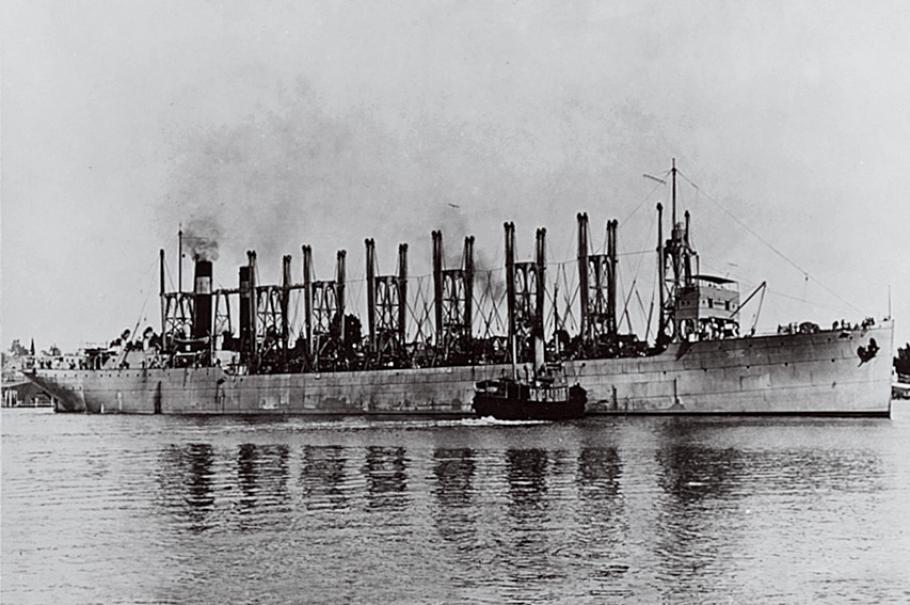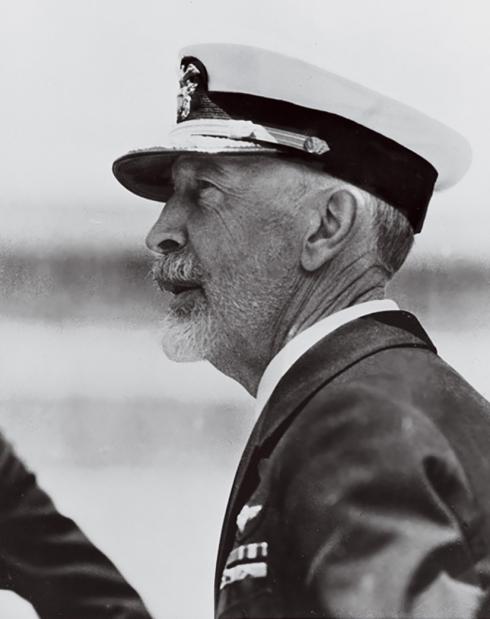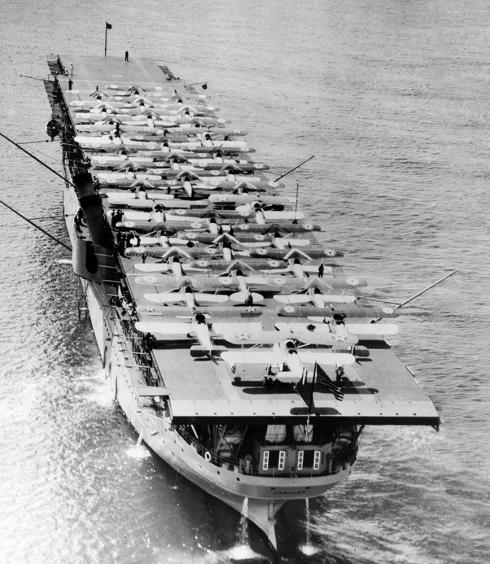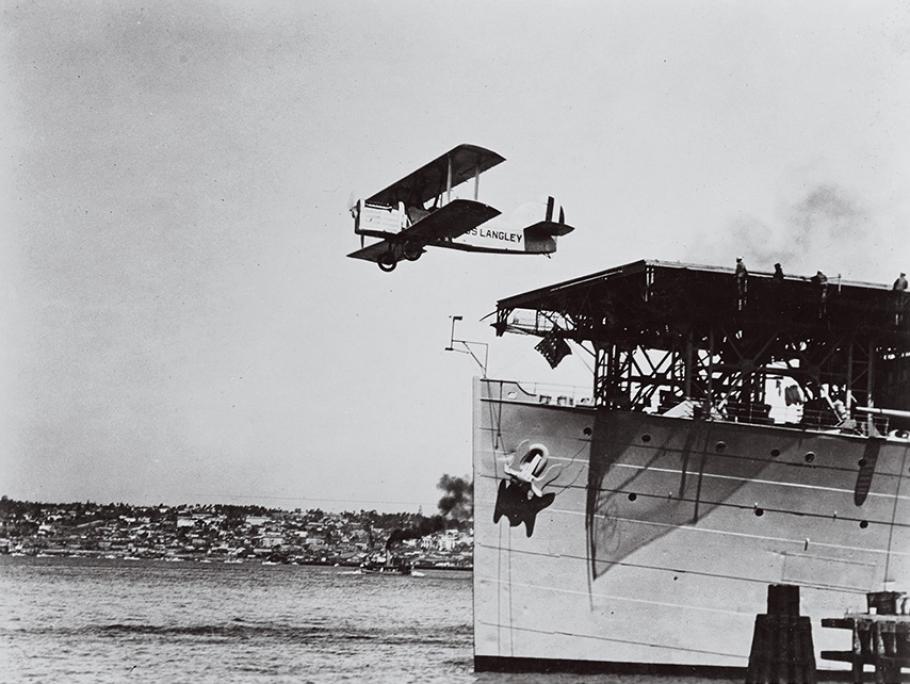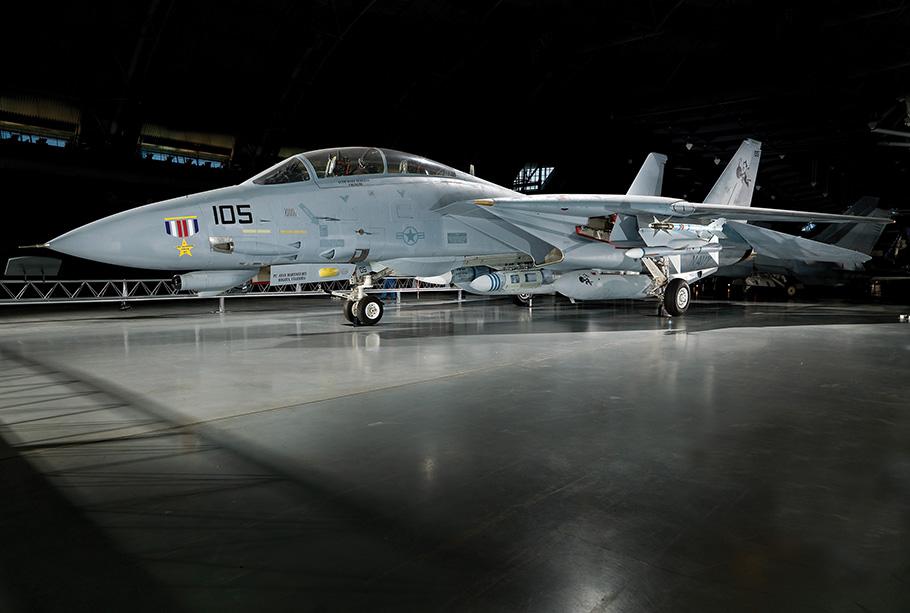A century ago, the U.S. Navy commissioned the USS Langley—an ungainly new ship that would forever change military aviation.
They’ve been called “Cities at Sea.” Crewed by as many as 5,000 sailors and measuring more than 1,000 feet long, an aircraft carrier is a floating air base able to project power almost anywhere in the world, carrying as many as 90 aircraft. This year, the carrier celebrates its 100th birthday, born in the form of the USS Langley, a plodding little flattop commissioned in 1922. The Langley was an experiment to see if aircraft could operate effectively off ships. Langley showed it could be done, and then trained the U.S. Navy’s first generation of carrier aviators.
The First World War was a proving ground for naval aviation, when both British and American shore-based seaplane units were tasked with flying anti-submarine patrols. The Royal Navy also experimented with launching wheeled aircraft off wood platforms grafted onto warships. Upon completion of a mission, pilots would either land ashore or—if unable—ditch alongside to hopefully be fished out of the water.
“The British were reluctantly forced to take airplanes to sea to fight Zeppelins,” says USS Midway Museum historian Karl Zingheim. “Germany’s Zeppelin fleet was causing all kinds of problems for the British in the North Sea as long-range eyes in the sky tracking their fleet movements.”
In July 1918, seven Sopwith Camels from HMS Furious launched on a daring early morning raid from the North Sea, destroying two Zeppelins at the Tondern airship base, from which Germany had also been conducting night bombing raids over Britain. The ship-borne air attack was a complete surprise to the Germans, who had previously thought the base beyond reach of British aircraft.
This successful effort did not go unnoticed by certain American and Japanese naval observers who began to visualize experimenting with specialized “airplane carrier” ships that could both launch and then recover aircraft. “In America’s case, that became the Langley,” says Zingheim. While the war had convinced Navy brass that airplanes were indeed essential, many senior naval officers believed aviation had little value to the fleet beyond scouting and observing the fall of shot for battleships.
Whiting spearheaded the effort to transform the vessel into America’s first aircraft carrier, the USS Langley.
Naval Aviator Number 16
But there were also forward-thinking naval officers who believed that ship-based aircraft would one day prove useful beyond their scouting roles. One was Commander Kenneth Whiting, a quiet, well-respected naval aviator who had commanded the Navy’s first aeronautic detachment when it deployed to France during World War I. Earlier in his career, as a young submarine skipper stationed in the Philippines, Whiting had made a name for himself by demonstrating that submarine crews could save themselves by exiting a submerged sub through a torpedo tube. Climbing aboard his submarine after it had surfaced, he simply remarked, “It’s easy.”
Seeking new challenges, Whiting was one of the first to join the nascent aviation branch and had the distinction of being the last naval aviator trained by Orville Wright. He was designated Naval Aviator No.16 in September 1914.
Three years later, his aviation unit was transported to France aboard a Navy collier, the USS Jupiter. Normally, the Jupiter was in the unglamorous business of refueling other ships with coal, but it assumed other duties during the war, carrying both cargo and personnel. Whiting, clearly thinking ahead, took note of the ship’s large cargo holds, one of the few Navy ships with space roomy enough to accommodate aircraft.
On March 8, 1919, during a Navy general board meeting to discuss the Navy’s 1920 budget appropriations, Whiting advocated converting a ship for the sole purpose of operating aircraft, telling the board, “We would also like to have right now, some sort of ship to take planes around with the fleet.” The sort of ship Whiting had in mind was one like the Jupiter.
Despite resistance within the Navy hierarchy to retain the six-year-old vessel as a fleet collier, Whiting and other like-minded naval officers ultimately won that bureaucratic battle and, in July 1919, the U.S. Congress authorized funds for conversion of the Jupiter into America’s first aircraft carrier.
Naval aviator Kenneth Whiting.
On-The-Spot Adaptation
The Jupiter entered the Norfolk Navy Yard for conversion in March 1920. Initially, shipyard personnel weren’t quite sure what the aviators wanted, beyond a long open deck for airplanes to operate from. And as Rear Admiral Jack Tate, then a young pilot assigned to the ship, noted in a Naval Aviation News article published in December 1970, “A great deal of the design was an on-the-spot adaption [sic].”
The Jupiter’s tall derricks, along with other coal-handling equipment, were removed. Then, latticelike girders were erected over the ship’s main deck and bridge to support a wood flight deck about 534 feet long and 64 feet wide. “She was just a floating flight deck,” explains Zingheim, “what went below was an afterthought.”
The flight deck, looming some 30 feet above the open main deck, or “hangar” deck, allowed for a traveling crane to lift aircraft out of holds and shuttle them along the hangar deck for service or to an elevator used for raising aircraft to the flight deck above. Two large cranes for hoisting seaplanes aboard were also fitted on either side of the hangar deck, and a compressed-air catapult for launching seaplanes was installed on the bow.
Whiting, while aboard the USS Jupiter during World War I, took note of the ship’s large cargo holds.
So as not to interfere with flight ops, smokestacks that could be pivoted to a horizontal position were installed toward the stern, along with retractable flag masts. And then there was the large carrier-pigeon house located on the ship’s fantail.
With the new configuration came a new name, and the once work-a-day collier was recommissioned as the USS Langley (CV-1) on March 20, 1922. The Navy’s first carrier was named in honor of Samuel Pierpont Langley, a celebrated astronomer and early aviation pioneer. (In 1887, Langley became the third secretary of the Smithsonian Institution.)
With the carrier’s commissioning, Commander Whiting, now the ship’s executive officer, was determined to prove the ship’s value to the fleet. The Langley became a technology demonstrator, a floating testbed developing new techniques to launch and recover aircraft.
Using existing aircraft modified for carrier duty—by strengthening their landing gear and adding hooks for arrested landings—the initial cadre of 15 aviators practiced spot landings ashore. One of the first challenges was determining the best way to stop an aircraft once it touched down on deck. Different ideas were tried out on a wood platform erected onshore by Lieutenant Alfred “Mel” Pride, who was assigned the task of coming up with a workable system.
“Nobody knew much about arresting gear,” recalled Pride in a U.S. Naval Institute Proceedings article. “I have no idea why Lieutenant Commander Godfrey ‘Chevvy’ Chevalier picked me, one of his pilots, to design the arresting gear for the USS Langley. He walked up to me one day in the summer of 1921 and told me to stay ashore at Norfolk and begin work. I said ‘Aye, aye, sir,’ and that was that.”
What was decided upon was five rows of cross-deck wires strung across the aft part of the flight deck to engage an airplane’s trailing hook. Any of the wires, once hooked, provided a retarding force by lifting attached weights through a block-and-tackle mechanism.
When the Langley first set sail in September 1922, it was to test gear and begin figuring out how to work the flight deck.
Lieutenant Commander Virgil “Squash” Griffin made the first takeoff from the flight deck on October 17, 1922, in a Vought biplane. Nine days later, Chevalier made the first landing aboard the Langley while it was underway—but not without nosing over and damaging the wood propeller of his Aeromarine 39 trainer in the process. Still, even this awkward arrival was cause for celebration, which the aviators did once ashore. Sadly, Chevalier was killed a short time later in a crash while flying a Vought from Naval Air Station Norfolk to Yorktown, Virginia.
While the Langley was undergoing conversion, naval aviation had gotten a big boost on September 1, 1921, when the Bureau of Aeronautics was established to manage all aviation activities within the Navy Department. Headed by Rear Admiral William Moffett, naval aviation now had a dynamic leader who could promote its development within the Navy and before Congress.
The support of Congress and the general public was crucial because of controversy surrounding U.S. Army Air Service General William “Billy” Mitchell’s use of bombers to sink surplus warships the previous July. Following these trials, Mitchell argued that America could be better served, and more cheaply defended, by squadrons of Army bombers rather than fleets of expensive warships. For its part, the Navy wanted funding for bigger carriers that would be fast enough to keep pace with and support the battle fleet. “It should be emphasized,” says Zingheim, “that the Langley was just a proof-of-concept test vehicle, something to work out the kinks while the planners were figuring out how to make a full-fledged warship out of an aircraft carrier.”
Moffett’s efforts were successful, and in July 1922, Congress authorized the completion of two battle cruisers already under construction as aircraft carriers: the USS Lexington (CV-2) and the USS Saratoga (CV-3). Both of these ships, commissioned in 1927, proved crucial a generation later during the early days of World War II. The tactical doctrine, equipment, and flight procedures that made them so effective would be pioneered on the Langley.
An aircraft, possibly a Vought VE-7, is loaded on an elevator aboard the Langley’s flight deck in 1923.
Covered Wagon Tours
With open sides and a wood flight deck held high overhead like a canopy, the Langley was an ugly duckling of a ship known to its crew as the “Covered Wagon,” with one officer going so far as to describe the warship as “this poor comic ship.”
The Langley shook off such dismissals and, after officially joining the fleet in 1923, the ship would spend time touring the East Coast, ranging as far north as Bar Harbor, Maine.
Moffett, a savvy political player in a time of budget austerity, had sensed wavering official support for the conversion of the battle cruisers into the bigger, more capable aircraft carriers the Navy needed. In June 1923, he summoned the Langley to Washington to sway minds—and that it did. The Langley’s airplanes were a sensation and good PR for naval aviation, with many citizens and politicians turning out just for the novelty of seeing airplanes land and take off from a ship.
Still, naval aviation remained a work in progress. By trial and error, Whiting and other early naval aviators learned how to fly from a carrier. Initially, various types of landing approaches were flown by different pilots. But as Lieutenant Pride was able to make the best, most consistent deck landings by flying a slow, nose high, power-on turning approach, his technique was adopted as standard.
During the Langley’s first six months of operation, amid the roar of aircraft engines, there rang out a new set of commands first heard on its decks and passed along to those who followed: “Rig the deck,” “Pilots, man your aircraft,” and “Stand by to start engines,” being among them.
Another Langley innovation was that of the landing signal officer, created when Whiting, positioned on the Langley’s stern, anxiously watched his fellow pilots during their landing approaches. Seeing an approach that wasn’t quite right, he would unconsciously make hand signals indicating the needed corrections. He was surprised to learn that pilots were observing his body language. Fellow aviators decided that having an experienced man guiding incoming airplanes was a good idea. Recalled Tate: “Thus, the idea for a landing signalman was born.”
Crewmen inspect damage to a Vought O2U Corsair amphibian aircraft that was partially burned in a crash. Accidents were common as first-generation carrier pilots and deck crew faced a steep learning curve.
At first, the Langley had no assigned squadrons: It was used strictly as an experimental platform for the testing of arresting gear, catapults, and aircraft. But most importantly, the ship was tasked with training the Navy’s first-generation carrier pilots and deck crew. The learning curve, as related in Our Flying Navy, published in 1944, was steep:
“ ‘Instrument face’ was the distinguishing mark of the Langley’s pilots, who loosened teeth and flattened noses against their instrument panels while negotiating the hazards of landing on the Langley’s small flight deck and crude arresting gear. Planes went overboard, piled up in the crash barrier, stood on their noses, and came apart. But the science of carrier operations was developed as a monument to these pilots’ perseverance.”
Under the leadership of Joseph Reeves, the number of embarked aircraft increased from eight to 42.
On November 29, 1924, the Langley joined the Pacific Battle Fleet in San Diego, and soon thereafter, Fighting Squadron VF-2 came aboard, becoming the first fighter squadron (flying nine Vought VE-7SF biplanes) assigned to a Navy carrier.
The Langley took part in its first battle fleet exercise in March 1925, with its airplanes flying scouting missions ahead of the fleet. “Very quickly they figured out during exercises that the Langley was really useful,” says Zingheim. “The admirals were soon pounding tables saying, ‘we need to get Lexington and Saratoga in the fleet now!’ ” The Navy’s top admiral not only recommended the accelerated completion of both ships, but the development of new purpose-built carrier airplanes as well.
The Force Multiplier
Possibly the biggest innovator in carrier tactical doctrine was Captain Joseph Reeves. Known as “Bull” since his U.S. Naval Academy football days, Reeves, while head of the tactics department at the Naval War College in the 1920s, envisioned aircraft as offensive weapons, not just scouts. In October 1925, this shrewd and forceful officer was designated Commander Aircraft Squadrons, Battle Fleet, and tasked with formulating effective carrier tactics. After quietly observing operations aboard the Langley for a month, he set about introducing changes.
Reasoning that a carrier would have more offensive punch with more airplanes, Reeves pushed to increase the number aboard. “Initially, his officers felt the Langley could only safely carry eight aircraft,” says Rob Doane, curator of the Naval War College Museum. Reeves would have none of that and pushed through changes, eventually increasing the number of embarked aircraft to 42, while dramatically increasing the efficiency of flight operations through continuous drilling of the flight deck’s crew.
Under Reeves’ leadership, officers introduced specialized jobs within the flight deck crew, who wore different colored jerseys that identified them with a specific task during flight operations: yellow shirts were airplane directors, purple shirts dealt with fueling aircraft, and blue-shirted personnel muscled airplanes about the flight deck. Standardized hand signals were also developed for quickly communicating above the din of turning aircraft engines.
Prior to Reeves’ arrival, procedure was for an aircraft to land and then be lowered to the hangar deck on the ship’s sole elevator before the next airplane landed. Tate observed that this process could take up to 12 minutes. That was far too time consuming if the Langley was to become an effective fighting ship.
“Reeves realized early on that the procedures they had really weren’t going to work,” says Doane. “One of his key innovations was speeding up the landing-and-takeoff cycle.”
Reeves did it by pressing deck crew to synchronize their movements on the flight deck. Once an airplane landed, it was disengaged from the arresting gear and quickly moved to the bow to clear the landing area for the next arrival. A collapsible net crash barrier was set up to protect airplanes parked forward from landing aircraft that didn’t catch a wire. “Once all the aircraft were back aboard,” notes Doane, “they were pushed aft to be rearmed and refueled. Recovery time was cut in half, and the Langley began generating more sorties than previously thought possible.”
By realizing that a carrier’s combat potential was directly related to its sortie rate, Reeves’ innovations had effectively become a force multiplier. Under his command, the Langley ceased to be an experiment. She had become a warship.During a fleet exercise off Hawaii in spring 1928, the Langley launched 35 aircraft in seven minutes, an outstanding achievement for the time. The carrier’s airplanes also mounted a simulated dawn attack on Oahu’s Army defenders, taking them by complete surprise. The Langley’s newly developed Boeing F2B-1 fighters—purpose built for carrier duty—easily held their own against Army fighters.
During a fleet exercise off Hawaii in 1928, the Langley launched 35 aircraft in seven minutes.
Loss of a Lady
After serving five years as the nation’s only aircraft carrier, the Langley was joined by the much faster, more capable Lexington and Saratoga in 1927. Although the Langley greatly influenced the design of these two new carriers and trained the corps of aviators and personnel that crewed them, technology had left the ship behind and the Langley’s days as a carrier were numbered. In 1936, the Navy started the process of converting the Langley into a seaplane tender by removing the forward portion of the flight deck.
Soldiering on in the Pacific, the Langley was operating off the Philippines when war broke out in December 1941. Initially dodging the Japanese onslaught, she reached Darwin, Australia on January 1, 1942, where she supported anti-submarine patrols being flown out of Darwin. One month later, the Langley was tasked to deliver desperately needed U.S. Army fighters to the port of Tjilatjap in the Dutch East Indies. Parked wingtip to wingtip, the 32 Army P-40 Warhawk fighters perched on her flight deck were destined for Allied forces attempting to hold back a Japanese invasion of Java.
Modest beginnings: A Douglas DT-2 takes off from the Langley’s flight deck in 1925.
The Langley never made it. Set upon by a force of Japanese bombers and fighters, the Langley’s skipper skillfully dodged the first salvos of bombs that rained down from the sky. But on the third pass, the ship took direct hits, setting the decks ablaze. Despite the fires and damage, the skipper made a gallant attempt to reach port in Java. But once the ship’s engine room flooded and propulsion was lost, he gave the order to abandon ship. The Langley’s escorting destroyers scuttled her with gunfire and torpedoes.
The pioneering “First Lady” of naval aviation, where the call of “Pilots, man your planes” first boomed across her decks nearly a century ago, rests today beneath the Java Sea. But the Langley’s legacy endures aboard the massive nuclear-powered carriers that now sail with America’s fleet.
Robert Bernier got his carrier qual trapping aboard the USS Lexington in a mighty T-28C Trojan during the fall of 1972.
The Museum’s Steven F. Udvar-Hazy Center has a Grumman F-14 Tomcat, an aircraft type forever immortalized by films like Top Gun and The Final Countdown.
Phantoms and Tomcats
Air & Space Quarterly spoke with Michael Hankins, the Museum’s curator for U.S. Air Force, Navy, and Marine Corps Post-World War II Aviation, about Navy aircraft and how they are different than their land-based counterparts.
What distinguishes Navy aircraft from those used by the Air Force?
When aircraft land on a carrier, they use a tailhook, a literal hook on the back of the airplane that grabs one of several cables laid out across the flight deck and rapidly decelerates and stops an aircraft before it runs off the end of the flight deck. When airplanes take off, they use a catapult system—the landing gear of the airplane is attached to a giant steam-powered catapult that can accelerate the airplane to takeoff speed extremely fast. The F-14 Tomcat, when making a catapult launch, goes from 0 to 160 miles per hour in just two seconds.
The operational demands of the carrier environment put extreme stress on the airplane, especially on the landing gear, so Navy aircraft tend to be a lot more rugged and have much more durable landing-gear systems than their land-based counterparts. The Navy also needs to accommodate a large number of airplanes on the ship. For example, the USS Dwight D. Eisenhower, a Nimitz-class aircraft carrier, usually carries about 90 aircraft. To save space, Navy aircraft tend to have foldable wings. This is one of the most visually striking aspects of the Navy aircraft on display at the Museum—that they have folding wings.
Do you have a personal favorite among these aircraft?
I will probably take some heat for this—because I think I’m in the minority—but my favorite Navy airplane by far is the F-4 Phantom II. Some people really dislike that airplane: It has nicknames like “Double Ugly,” and during its development, people said it would fly just as well going backward as forward.
But I think the Phantom is a beautiful airplane. The tall, curved intakes on the sides, the way the wingtips bend up and the horizontal stabilizers bend down—there’s something about the look of that airplane that I find inherently exciting and just plain cool. But beyond that, it’s a very successful airplane that proved capable and versatile in the Vietnam War—both in ground-attack roles and in iconic air-to-air combat with Soviet-designed MiG fighters.
That said, I’d be remiss if I didn’t talk about my love of the F-14 Tomcat. It’s got an incredibly cool look, with wings that can sweep backward and forward, and the way the wings connect to the fuselage with a bird-like quality. I always find myself staring at the Tomcat when I walk through the Museum. The F-14 was also very successful. Although not as combat-tested as the Vietnam-era Phantom, the Tomcat played an important role during Operation Desert Storm, and was the frontline fighter for the Navy for the last part of the Cold War. The Museum’s Tomcat shot down a MiG-23 in 1989.
Any intriguing facts about these aircraft you’d like to share?
The F/A-18 Hornet can trace its origin to an Air Force project. In the early 1970s, the Air Force asked for two prototypes of a “lightweight fighter,” a fighter that was smaller and less expensive than the others in development at the time— like the F-14 and F-15.
The winning prototype went on to be the F-16 Fighting Falcon, but the other prototype was the Northrop YF-17 Cobra. Initially, the Navy evaluated the F-16 to see if a Navy version of that aircraft would be possible, but they decided against it. Instead, they took the YF-17 as a starting point, using it as the basis for the airplane that became the F-18.



